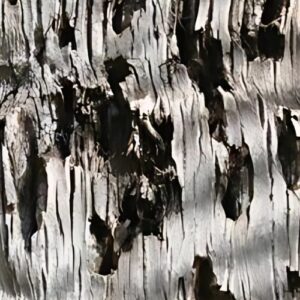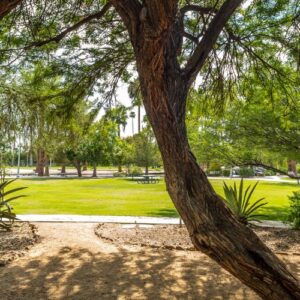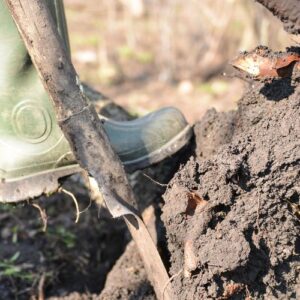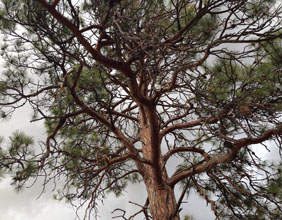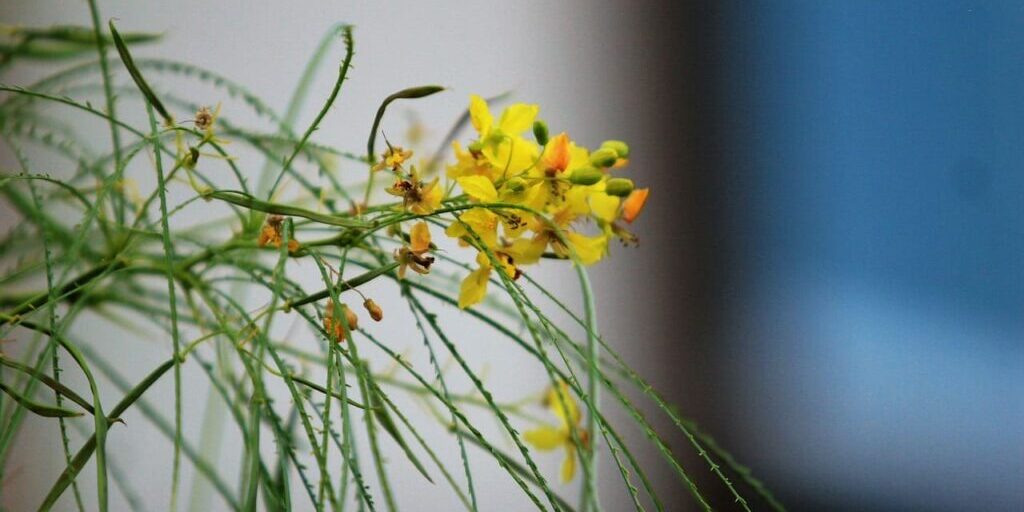
The palo verde tree is Arizona’s state tree, but do you know all of the different types? Both the foothills palo verde and blue palo verde are native to the state, and both of them are the official Arizona state tree (although some have decided that the blue palo verde alone has that honor). Other varieties are hybrids or are native to Mexico, Central America, or South America. But with so many options, how do you know which is the best palo verde tree for your yard?
In this article, we include:
- detailed descriptions of five of the most common types of palo verde trees found in the Phoenix area,
- ways to identify different types of palo verde trees,
- differences between the palo verde varieties,
- pros and cons of planting each kind of palo verde,
- the best uses for each type, and
- a few of the lesser-known types of palo verde.
Once you know the features of each type, you’ll be able to choose the best palo verde variety for your own Phoenix area yard.
About Palo Verde Trees
Palo verde trees are easily recognized by their green branches, and by the bright yellow flowers that are blamed for allergy symptoms in the spring. A native tree or shrub that is often found in the wild, they have survived in the Phoenix area through many droughts and monsoons.
Palo verde trees are considered drought-deciduous. Many of them drop their leaves when water is scarce, rather than at a specific time of year. Alternatively, they’ll quickly grow new leaves right after a significant amount of rainfall.
Unlike almost every other plant and tree, palo verde trees are able to survive without their leaves. That’s because the green color in the branches is caused by chlorophyll, the ingredient needed to perform photosynthesis. As a result, palo verde trees are still able to produce the “food” needed for survival, even during periods of drought.
A true example of how different species work together in the wild, palo verde trees are an important nurse plant for the saguaro cactus. You’ll often find saguaro growing under palo verde trees, which provide shelter and protection from the elements during the early years of a saguaro’s life.
As mostly-native trees, few things can seriously harm this tree, but common issues include:
Types of Palo Verde Trees Found in the Phoenix Area
All palo verde trees are part of the Parkinsonia family. The various types of palo verde trees differ in how long they live, the shape and size of their leaves, whether or not they have thorns, flower color and timing, and how fast they grow.
We describe the most well-known members of that family below, starting with the ones most often found in the Phoenix area. You can use this guide to help choose the best palo verde for your yard.
Blue Palo Verde (Parkinsonia florida)
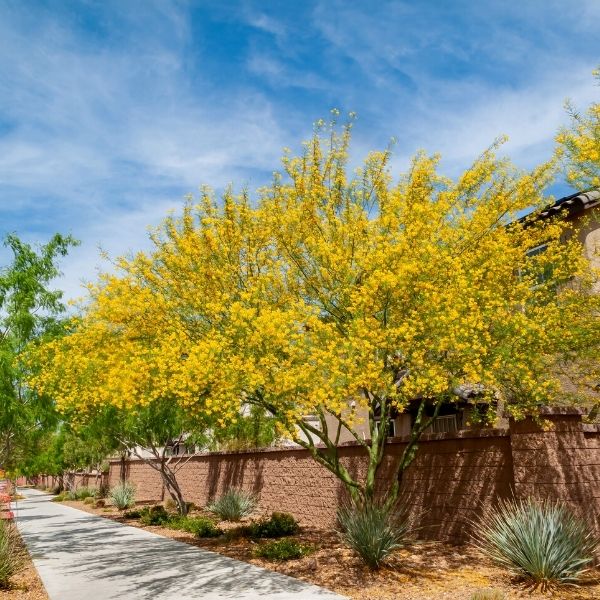
Size: Grows to 30-40 feet tall and 30 feet wide
Leaves: One pair of pinnae with 2-4 pairs of leaflets
Flowers: Bright yellow, plentiful
Distinguishing features: Gray-blue color
Growth rate: Fast
Seeds: Yes, large pod that doesn’t constrict around seeds
Thorns: Yes, small spines along branches
When people talk about palo verde trees, most are referring to the blue palo verde. It has become one of the most popular types of palo verde trees found in Arizona, where it’s naturally found near washes or other sources of water. The leaves, branches, and trunk are a gray-blue color, which is how it got its name. In landscape settings, it may need to be watered monthly during the summer months but otherwise can survive on natural rainfall.
The blue palo verde tree grows relatively quickly and can live to 100 years (although it rarely does so). It does well in sunny areas and can survive in temperatures down to 12 degrees F.
It produces seeds that are food for wildlife (and are edible for humans, too!). The seedpods of the blue palo verde are slightly larger and flatter than the foothills palo verde.
Bees enjoy the yellow flowers, which are technically edible as well and are sometimes added to salads. Blue palo verde trees flower in early spring, about 3 weeks before the foothill palo verde.
Since it’s naturally found near washes, it needs more water than the foothills variety.
Best Uses for the Blue Palo Verde
The blue palo verde is best used in large yards, parks, or other wide-open areas. Before planting, consider whether you want to deal with the messy seed pods and flowers, as well as the thorns. It often needs maintenance pruning to remove deadwood and keep it structurally sound. The blue palo verde can do well in lawns BUT we don’t recommend planting it in turf. Shallow frequent irrigation can cause shallow roots, which is one of the main causes that trees are uprooted in storms.
Foothills Palo Verde, Little Leaf Palo Verde, Yellow Paloverde (Parkinsonia microphylla)
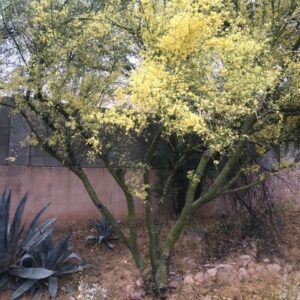 |
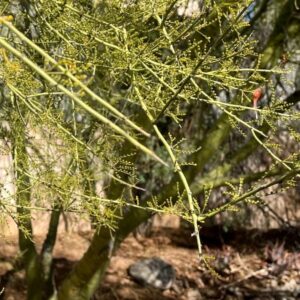 |
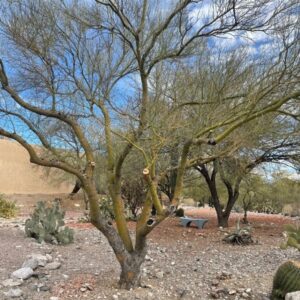 |
Size: Grows to 10-20 feet high and 10-20 feet wide
Leaves: Tiny, one pair of pinnae with 4-8 pairs of leaflets each, appear on the tree only after rainfall (or watering)
Flowers: Four yellow petals and one white petal
Distinguishing features: Smallest leaves of any in the Parkinsonia family, spine at the end of each branch, lime green colored trunk, branches, and leaves
Growth rate: Slow
Seeds: Yes, large seeds and a pod that constricts around the seeds
Thorns: Yes, at the end of each branch
The foothills palo verde is often found on hillsides and is considered a large shrub or small tree. The names “little leaf and “yellow” are self-explanatory, as the foothills palo verde has the smallest of all palo verde leaves, and the flowers in spring make the tree appear to be yellow. The name could also be due to the yellow-green tint of the tree itself and the yellowish-green leaves.
While drought-tolerant when mature, the seedlings need adequate water for the first 2-3 months or they will die. In the wild, only about 1.6% of foothill palo verde seedlings will survive. Despite this, it is one of the most common trees found in the Sonoran Desert.
One way to spot a foothills palo verde is by the spring flowers – they often have four yellow petals and one white petal, which gives an overall light-yellow look to the tree when in bloom.
Native to the Tucson basin, it is moderately slow growing, with irregular upright branches. Because of the slow growth, it can live for several hundred years.
A foothills palo verde can survive on little water but benefits from monthly watering during the summer months.
It produces seeds, nectar, and shade for wildlife. Seeds are safe to eat for humans and were traditionally ground into flour to make soup, roasted, or eaten raw. The seeds can also create a lot of mess, so we suggest that you don’t plant this type of tree near a pool.
An extreme method that the foothills palo verde has in surviving in the desert (and one of the reasons, perhaps, that it lives longer), is that it will occasionally shed branches during periods of drought. On the one hand, you can look at is as natural pruning. On the other hand, be prepared for falling branches if the tree doesn’t get enough water.
Remember, though, it doesn’t do well in over-watered areas, such as near lawns that are irrigated frequently.
Pests and Issues with the Foothills Palo Verde
Mistletoe, palo verde beetles, and buffelgrass can kill seedlings by using up all available water. The foothills palo verde cannot withstand deep planting or prolonged periods with excess soil at the tree base – this often leads to root rot or tree failure.
Best Uses
The foothills palo verde is a good choice for smaller spaces, courtyards, and yards, but don’t plant it close to walkways due to its thorns and low canopy. It can survive on less water than the blue palo verde so is naturally found in more rocky environments and hillsides. Keep in mind that it is the slowest-growing of all palo verdes so it will take longer to reach its full height – but it will also last longer. It does not do well in lawns so avoid planting it in or near areas of irrigated turfgrass.
Mexican Palo Verde, Jerusalem Thorn, Jelly Bean Tree (Parkinsonia aculeata)
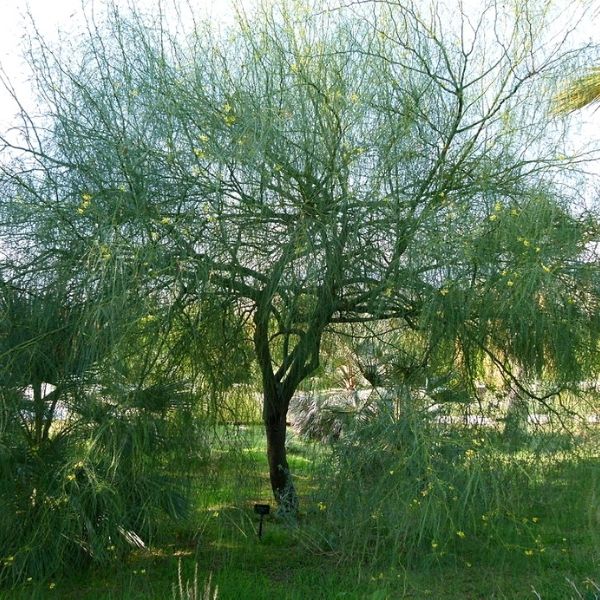 |
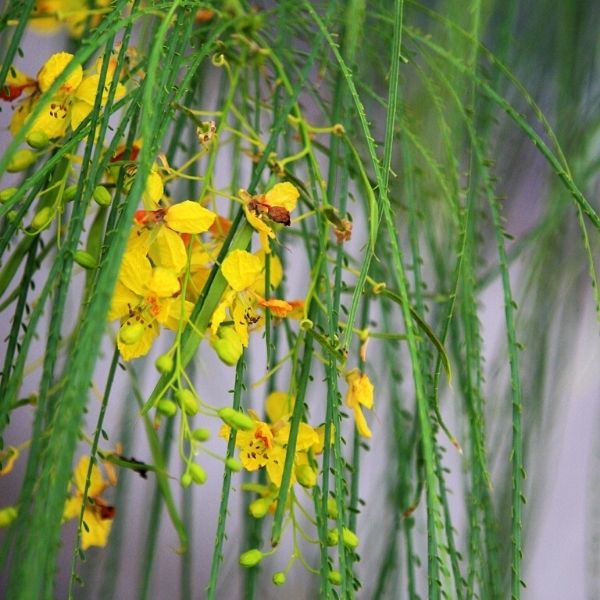 |
Size: Grows to 6-35 feet high and 6-20 feet wide
Leaves: 6 to 9-inch long compound leaves with many (25-30) tiny leaflets that fall off in dry weather, leaving long, stringy, willow-like strands
Flowers: Yellow-orange
Distinguishing features: Thorns and willow-like branches
Growth rate: Fast
Seeds: Yes
Thorns: Yes, on stems
Despite the “Jerusalem” name, the Mexican palo verde tree is native to the Sonoran and Chihuahan deserts – though not originally in Arizona. The “jelly bean” name comes from the seed pods, which can resemble several jelly beans together.
The Mexican palo verde has long, thin branches with small leaves, giving it a willow-like appearance. It grows very quickly but has a short life span (15-20. Years). It is often spotted near washes but can work as a street tree in urban environments. If not pruned, it can become more wide than tall, with little clearance underneath.
The Mexican palo verde prefers well-drained soil but can survive in poor soil conditions with little water and is somewhat salt-tolerant. In periods of extended drought, it becomes more of a shrub than a tree. Although it survives well with little water, it can handle more water. Be aware, though, that if it receives irrigation it will often produce suckers on the trunk.
The stems have small thorns so it is not a good tree to plant near walkways. Because it grows so rapidly, the branches are brittle and break easily in monsoons. The seeds produce a lot of litter and the tips of the spines can easily break off and injure (and sometimes infect) skin.
P. aculeata is considered an invasive species in tropical and subtropical regions of the Pacific. It is actually listed as Australia’s worst weed and is considered invasive in Phoenix now as well.
Pests and Issues with the Mexican Palo Verde
The Mexican palo verde is the primary host for the palo verde beetle. In many areas it’s considered a “trash” tree because it doesn’t live long, the branches break easily, the seeds create a mess, and thorns are an issue.
Best Uses
This tree is best used in large medians away from walkways. We don’t recommend it for yards or other landscapes due to its short life, messy leaves, and propensity to reseed in vacant lots and washes.
Desert Museum Palo Verde (Parkinsonia x ‘Desert Museum’)
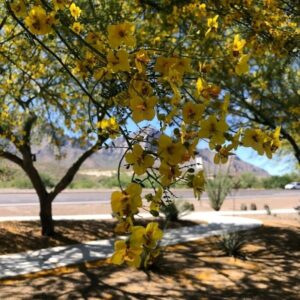 |
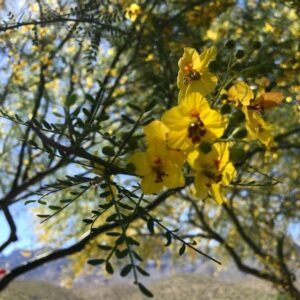 |
Size: Grows to 20-30 feet high and 20-40 feet wide
Leaves: One or two pairs of pinnae that are 2-4 inches and have 9-19 pairs of leaflets per pinna
Flowers: Many yellow blooms, slightly larger than on its 3 parent trees, will bloom first and longest (usually March through May)
Distinguishing features: Dark green trunk, thornless
Growth rate: Fast
Seeds: Yes, but not as many as other types
Thorns: No
A naturally occurring hybrid, many prefer the Desert Museum palo verde tree because it is thornless. The trunk is also slightly darker green than other types of palo verde trees.
It is a cross between blue palo verde, foothills palo verde, and Mexican palo verde (the three trees covered above). This hybrid was discovered in the 1970s at the Arizona-Sonora Desert Museum and thus named after it.
It has few seed pods, needs little water, and produces filtered shade that provides excellent growing conditions for many types of plants. It is also known for its copious amounts of yellow, fragrant blooms in the spring.
Growing at 24 to 36 inches a year, it takes after its fast-growing parents. However, it can live up to 150 years, taking after the slow-growing foothill palo verde.
It’s best grown in full sun and well-drained soil and does not react well to overwatering. Like other kinds of palo verde trees, however, it can benefit from monthly watering during the summer months.
Pests and Issues with the Desert Museum Palo Verde
Like other types of palo verde, the Desert Museum variety is susceptible to palo verde borer, witches’ broom, and mistletoe.
Best Uses
This tree is an excellent choice to plant near walkways and in most yards. It also works well as a large shade tree, where it provides light shade that still allows other plants to grow beneath it.
See Noelle Johnson’s Desert Museum Palo Verde and learn why it is her favorite (AZ Plant Lady)
Palo Brea, Sonoran Palo Verde (Parkinsonia praecox)
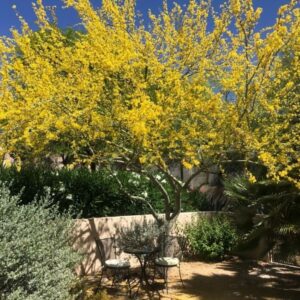
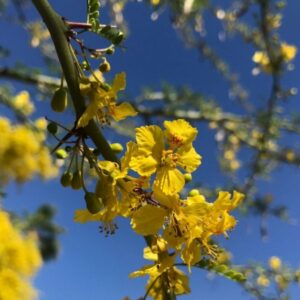
Size: Grows to 15-30 feet high and 15-30 feet wide
Leaves: Leaves stay on the tree most of the year. Bluish green or silver. Alternate, pinnate leaf arrangement and 1-2 pairs of leaflets
Flowers: Small orange dots on one petal (usually the upper petal)
Distinguishing features: Smooth lime-green bark all the way down to the ground, orange dots on flowers, twisting branches
Growth rate: Fast
Seeds: Yes
Thorns: Yes, many
The palo brea is native to Mexico, as well as Columbia, Peru, Venezuela, and Ecuador.
Twisting and interwoven green branches and a fully green trunk differentiate the palo brea tree from palo verdes. In spring, you can also look for orange dots on the upper flower petal of the yellow flowers.
It needs a lot of room to grow so is not well suited to be a street or parking lot tree.
It naturally has an umbrella-like shape, with few lower branches, so it is great for shade. The branches tend to go wherever they please, so professional pruning is highly recommended for this type of tree. Be careful not to over-prune, or you will ruin the natural uniqueness of this tree.
The smooth green trunk can be a beautiful attraction – but if planted too close to other things, near walkways, or if surrounded by animals, can be easily scratched.
Palo brea is a fast growing, multi-trunk tree that can live for many years. It has thorns and seeds that can be messy when they fall. It prefers full sunlight and well-drained soil.
Pests and Issues with Palo Brea
This tree is prone to mistletoe, as well as damage from palo verde beetles. It does not do well with excessive water so be careful not to overwater it.
Best Uses
The palo brea can be a good choice as a specimen tree in larger yards where it can be kept away from walkways and other areas where pets and people could come in contact with its thorns and twisting branches. Because of its relatively small size, you’ll sometimes see it planted below power lines.
Other Types of Palo Verde Trees
Along with the palo verde trees mentioned above, there are a few other varieties, found mainly in other areas of the world.
Argentine Palo Brea (Parkinsonia praecox subsp. glauca)
A smallish tree, the Argentine palo brea rows up to 20 feet tall.
As you can tell by the name, this palo verde is originally from Argentina. It is more of a large shrub, but the lower branches can be pruned as it grows to form a tree shape. It is very similar to the Sonoran palo brea but has smaller leaves and can tolerate colder temperatures (down to 10 degrees F).
Extremely drought tolerant, it can survive on 4 inches of rainfall a year, but it will grow faster if it receives more water.
“Brea” means “tar” or “pitch” in Spanish, referring to the waxy coating of the bark of the Argentine Palo Brea. In the past, this coating was scraped off and used as glue.
Sonoran Palo Brea (Parkinsonia praecox subsp. praecox)
This small to mid-sized tree grows to 15-30 feet tall and 15-30 feet wide.
Native to Mexico and South America, it is less drought tolerant than the Argentine Polo Brea, and can withstand temperatures down to 20 degrees F. However, it has the typical green bark, yellow flowers, and tan seed pods of other palo verde trees.
Best Palo Verde Trees for Phoenix Yards
As you look over the palo verde trees available to you, you have plenty of options! Note that the blue, foothills, and Desert Museum palo verde trees are all on the Anthem approved plants lists, as well as the palo brea. The Mexican palo verde is not. (The scientific name may be listed as Cercidium, which was the previous name before it was changed to Parkinsonia).
Things to keep in mind include:
- how tall or wide of a tree you prefer,
- how much litter from seeds and petals you can handle, and
- whether or not you are okay with thorns.
Remember that the palo verde is a desert tree, so
- DO choose one for your property if you have the room and want to save on water costs, but
- DO NOT choose a palo verde if you plan on planting it in turf, if you have poor-draining soil, or if you don’t have enough room for the tree to fully grow.
We hope you have enjoyed this comprehensive guide to our state tree! Please feel free to contact Titan Tree Care if you have palo verde trees that need pruning, if they don’t seem to be thriving, or if you’d like help in choosing and planting the right palo verde for your Phoenix yard.
More Articles Like This

Titan Tree Care is a full-service tree care company located in Anthem, AZ and serving all of North Phoenix. We offer a wide range of services to meet your tree care needs, including tree and palm trimming, tree pruning, tree removal, stump grinding, and more. We also offer insect or disease treatments and fertilization services. We are dedicated to providing high-quality, safe, and effective tree care services to our customers and work hard to ensure that your trees are healthy and look their best.





